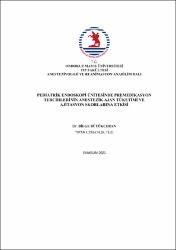| dc.contributor.advisor | Üstün, Yasemin Burcu | |
| dc.contributor.author | Büyükceran, Bilge | |
| dc.date.accessioned | 2023-04-13T05:34:41Z | |
| dc.date.available | 2023-04-13T05:34:41Z | |
| dc.date.issued | 2021 | en_US |
| dc.identifier.citation | Büyükceran, B. (2021). Pediatrik endoskopi ünitesinde premedikasyon tercihlerinin anestezik ajan tüketimi ve ajitasyon skorlarına etkisi. (Tıpta uzmanlık tezi). Ondokuz Mayıs Üniversitesi, Samsun. | en_US |
| dc.identifier.uri | http://libra.omu.edu.tr/tezler/136371.pdf | |
| dc.identifier.uri | https://hdl.handle.net/20.500.12712/33952 | |
| dc.description | Tam Metin / Tez | en_US |
| dc.description.abstract | Amaç: Hastaların aynı gün taburcu edildiği pediatrik endoskopi gibi girişimlerde
hasta güvenliği ancak iyi anestezi yönetimi ile sağlanır. Anestezi öncesi efektif bir
anksiyolitik ile premedikasyon uygulanması, işlem süresince ve derlenme
döneminde yaşanabilecek komplikasyon riskini azaltır. Bu çalışmada,
premedikasyon amacıyla sık uygulanan midazolam ve deksmedetomidinin;
hemodinami, sedasyon skorları, anestezik ajan tüketimi, derlenme - ajitasyon
skorları ve uygulayıcı memnuniyetleri üzerine etkilerini araştırmayı amaçladık.
Hastalar ve Yöntem: Çalışmamız Samsun Ondokuz Mayıs Üniversitesi Klinik
Araştırmalar Etik Kurulu’nun 26.11.2020 tarihli B.30.2.ODM.0.20.08/748 sayılı
onayı ile gerçekleştirildi. Tek merkezli, retrospektif çalışmamıza anestezi kayıtları
incelenerek 5-15 yaş arası 70 hasta dahil edildi. İşlemden önce premedikasyon
amacıyla 0.5 mg/kg oral midazolam verilen hastalar Grup M, premedikasyon
amacıyla 1 μg/kg intranazal deksmedetomidin verilen hastalar Grup D olarak
adlandırıldı. Hastaların demografik verileri, işlem süresi boyunca vital bulguları,
Ramsay sedasyon skorları, uygulanan ek propofol miktarı, işlem sonrası Steward
derlenme skorları, Emerge ajitasyon skorları kaydedildi.
Bulgular: Çalışmamızda Grup D’de 5. ve 25. Dakikalardaki kalp hızı daha
düşüktü. Diğer zamanlarda kalp hızı ve solunum sayıları açısından gruplar arasında
fark yoktu. Grup M’de ek propofol ihtiyacı daha yüksekti (p<0.05). Grup D’de
işlem öncesi, 3 ve 10. dk sedasyon skorları daha yüksek seyretti (p<0.05). Emerge
ajitasyon skorları Grup M’de daha yüksekti (p<0.05). İşlem sonrası derlenme
skorları Grup D’de daha yüksek bulundu. (p<0.05). Uygulayıcı memnuniyetleri
açısından iki grup arasında fark yoktu.
Sonuç: Deksmedetomidin; pediatrik GİS endoskopisinde premedikasyon amacıyla
kullanılan ajanlara iyi bir alternatif olabilir. Ancak sonuçlarımızın iyi planlanmış
prospektif çalışmalarla desteklenmesi gerektiği kanaatindeyiz. | en_US |
| dc.description.abstract | Background: In procedures such as pediatric endoscopy, where patients are
discharged on the same day, patient safety can only be provided with good anesthetic
management. Premedication with an effective anxiolytic before anesthesia reduces
the risk of complications during the procedure and during the recovery period. In this
study, midazolam and dexmedetomidine, which are frequently used for
premedication; We aimed to investigate the effects on hemodynamics, sedation
scores, anesthetic agent consumption, recovery and agitation scores, and operator
satisfaction.
Patients and Methods: Our study was carried out with the approval of Samsun
Ondokuz Mayıs University Clinical Research Ethics Committee, dated 26.11.2020,
numbered B.30.2.ODM.0.20.08 /748. In our single center, retrospective study, 70
patients between the ages of 5 and 15 years were included by examining anesthesia
records. The patients who were given 0.5 mg / kg oral midazolam for premedication
before the procedure were named Group M, and the patients who were given 1 μg /
kg intranasal dexmedetomidine for premedication were named as Group D.
Demographic data of the patients, vital signs during the procedure, Ramsay sedation
scores, the amount of additional propofol applied, Steward recovery scores after the
procedure, Emerge agitation scores were recorded.
Results: In our study, the heart rate at the 5th and 25th minutes was lower in Group
D. At other times, there was no difference between the groups in terms of heart rate
and respiratory rates. Additional propofol need was higher in Group M (p <0.05). In
Group D, sedation scores before the procedure, at the 3rd and 10th minutes were
higher (p <0.05). Emerge agitation scores were higher in Group M (p <0.05). Postprocedure recovery scores were higher in Group D. (p <0.05). There was no
difference between the two groups in terms of practitioner satisfaction.
Conclusions: Dexmedetomidine can be a good alternative to agents used for
premedication in pediatric GIS endoscopy. However, we are of the opinion that our
results should be supported by well-planned prospective studies. | en_US |
| dc.language.iso | tur | en_US |
| dc.publisher | Ondokuz Mayıs Üniversitesi, Tıp Fakültesi | en_US |
| dc.rights | info:eu-repo/semantics/openAccess | en_US |
| dc.subject | ameliyathane dışı anestezi uygulamaları | en_US |
| dc.subject | deksmedetomidin | en_US |
| dc.subject | derlenme ajitasyonu | en_US |
| dc.subject | midazolam | en_US |
| dc.subject | premedikasyon | en_US |
| dc.subject | dexmedetomidine | en_US |
| dc.subject | emerge agitation | en_US |
| dc.subject | midazolam | en_US |
| dc.subject | non-operating room anesthesia | en_US |
| dc.subject | premedication | en_US |
| dc.title | Pediatrik endoskopi ünitesinde premedikasyon tercihlerinin anestezik ajan tüketimi ve ajitasyon skorlarına etkisi | en_US |
| dc.type | masterThesis | en_US |
| dc.contributor.department | OMÜ, Tıp Fakültesi, Cerrahi Tıp Bilimleri Bölümü | en_US |
| dc.contributor.authorID | 0000-0002-2628-7543 | en_US |
| dc.relation.publicationcategory | Tez | en_US |
















